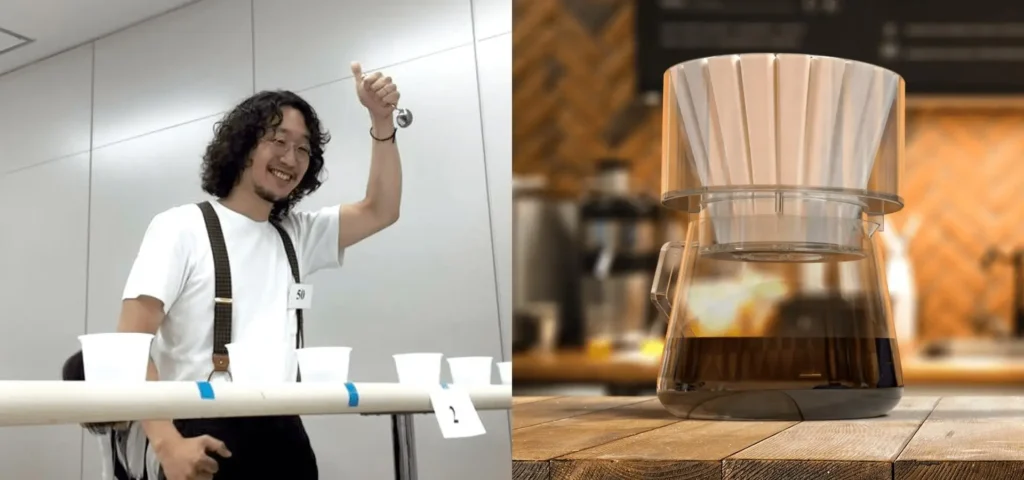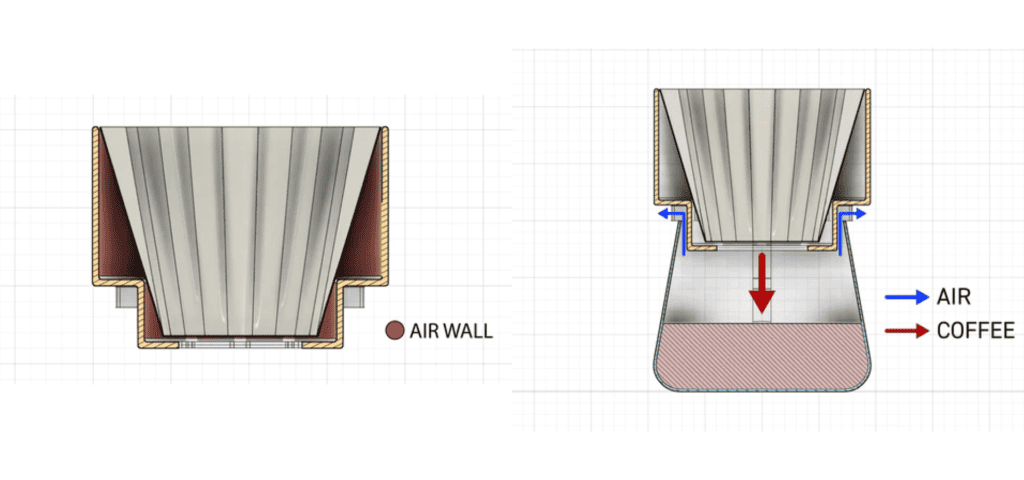Simplify the Brewer by Bathtub Coffee is a wide, flat-bed brewer that aims to combine pouring simplicity with high coffee extraction.
According to their website, you can achieve aromatic coffee with a one-pour method – a 30-second pour and a one-minute drawdown.
Is it achievable? Well, in this article, we’ll delve deeper and share the results.
About SIMPLIFY the Brewer

SIMPLIFY the Brewer is the brainchild of Ryo John Ito, the founder of Bathtub Coffee. Their philosophy centers around crafting a brewer that’s easily accessible to the everyday coffee enthusiast. This vision led them to launch the brewer on Kickstarter, promoting it as a means to achieve ‘fantastic coffee in just 30 seconds’ through their 1-pour method.
The brewer is made of crystal-clear Tritan™ and is lightweight, durable, and shock-resistant. Its thermal properties and wide 40mm diameter hole allow for a faster drawdown and better extraction.

Its circular chamber perfectly fits a Kalita wave paper filter, and the space between acts as a pseudo double-wall chamber. The three legs at the bottom of the brewer act as an air vent between the brewer and server, allowing for more airflow and a faster flow rate.
Personally, the material isn’t as tough as the Aeropress or OREA. It has shown some signs of scratches and can be broken if crushed by force.
Brewing with the 1-Pour Method
According to the 1-pour method described on their website, you only need to pour directly into the center of the coffee bed without any circular motion or pulsing, all within a 30-second timeframe.
The instructions also specify that the drawdown should ideally take between 60 to 90 seconds when using finely ground coffee. In the video, it was evident that they used a dark roast coffee. Dark roast coffee generally extracts faster than medium roast, and the use of a fine grind further accelerates the extraction process.
1-Pour Method by Bathtub Coffee
1. Set a paper filter in SIMPLIFY the Brewer, and rinse the paper filter (optional).
2. Pour water at the center of 15g fine ground coffee (NO circular motion!)
3. When you pour 230g of water for 30 seconds, stop it.
4. Wait for 60 to 90 seconds until all the water drops down the brewer.
5. Serve and enjoy!
No Bloom? No Stir? No Pulse?

Does a brew taste good without blooming? I’m definitely on the fence that you can do without blooming. The blooming process is to ‘expel carbon dioxide so that the water can access the flavours of the coffee without the potentially negative flavours of too much CO₂.’ – The Coffee Dictionary: An A-Z of coffee
Through testing with the 1-pour method using a medium grind, the coffee exhibited a weaker flavor profile, with the short brew time (1:30) also significantly affecting its taste.
Alternative 2-Pour Brewing Method
To address the issue of the short brew time and maximize extraction for medium roast coffee, I opted for a medium-coarse grind and maintained a water temperature of 90°C. Given the brewer’s similar brewing style to the Origami, I decided to use the same 2-pour method as employed with the Origami.
By making a slight adjustment to a finer grind than that of the Origami while keeping the temperature at 90°C, I was able to improve the brew time and drawdown to approximately one minute.
The result was a balanced and light cup of coffee with good clarity. I would describe the body as slightly lighter than that of the Kalita, with a level of clarity reminiscent of the Origami.
Brewing Method
1. Pre-wet the paper filter.
2. Add 13g of coffee and pour 40g of water during the bloom. Wait for 30 seconds.
3. At 0:30, pour with fast concentric circles around the brewer for up to 1:00.
4. As your brewer fills up to 160-200g, reduce the speed of your pour and end it at the center.
5. At 1:00, allow the coffee to draw down from the brewer for up to 1 minute.
6. At 2:00, remove the brewer and give it a stir to cool.
Conclusion
SIMPLIFY the Brewer creates a clean taste but with a weaker body when using the 1-pour method. However, I would imagine that this brewer would deliver a balanced taste when used with Japanese ‘Sumiyaki’ roast coffee or dark-roasted coffee.
Nevertheless, employing this method with specialty medium/light roast coffee did not yield optimal extraction. Due to its wide bottom, the drawdown was very quick with coarse grinds. It’s also challenging to use a finer grind, particularly for single pours.
Please feel free to share your thoughts if you’ve achieved good results with this brewer and your preferred recipe.
Thanks for reading. We hope you have gained some valuable insights from this post. Follow Art Of Brew on Instagram and Twitter or share your thoughts in the comments below.